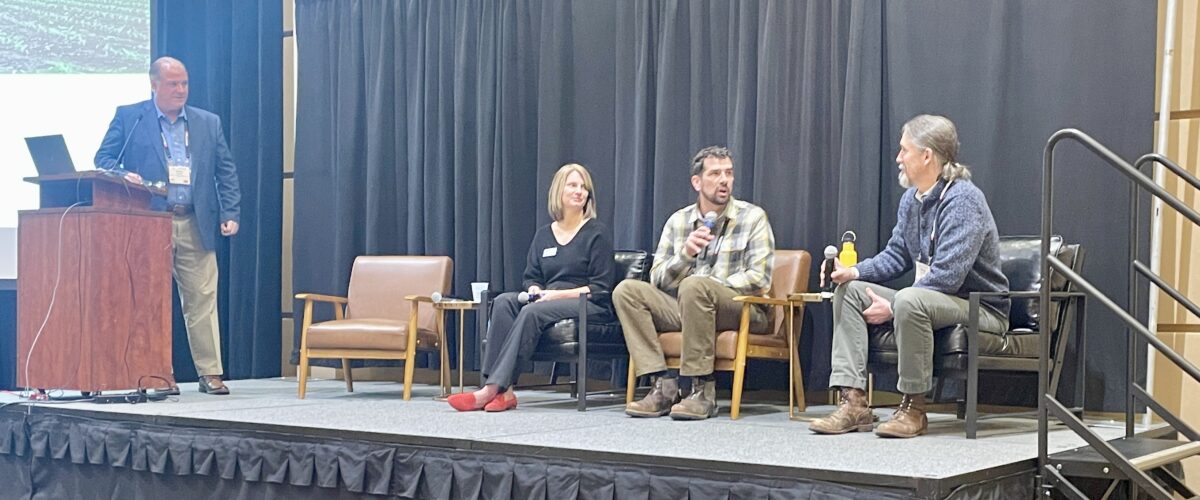Farmers received insights about the Dairy Soil & Water Regeneration (DSWR) project from its leaders and researchers at the Dairy Strong conference Jan. 16 in Green Bay, Wis.
Victor Green, director of soil health and crop sustainability for Dairy Management Inc. (DMI), provided an overview of the ongoing eight-year project and moderated a panel discussion in a breakout session titled, “Bridging the Data Gap for Dairy Farmers.”
DSWR is studying soil health and manure management and their effects on greenhouse gas reduction, water quality improvement and agronomic factors such as forage yield and quality. DMI and the Soil Health Institute (SHI) initiated the project in collaboration with research partners at seven universities and a U.S. Department of Agriculture research site across six major dairy states.
Green, a project lead, explained how DSWR fits into the dairy industry’s collective 2050 environmental stewardship goals: achieve greenhouse gas neutrality, optimize water use while maximizing recycling and improve water quality by optimizing use of manure and nutrients.
The panel featured Mara Cloutier, a research scientist and program director at SHI; Joshua Faulkner, a research associate professor who coordinates the Farming and Climate Change Program in the University of Vermont Extension Center for Sustainable Agriculture; and Gregg Sanford, an assistant professor in the Department of Soil & Environmental Sciences at the University of Wisconsin-Madison.
Key highlights from the discussion:
Creating a Baseline
Cloutier described the first main task of the project — creating a baseline of soil health and carbon storage on numerous farms around the country. To develop this baseline, 271 soil health samples have been collected in states with a wide range of climates and soil types.
“We largely see that the potential for soil health is greater in the humid areas,” Cloutier said. “It’s not necessarily that the practices are different or that farmers are managing differently in Idaho than New York, although that is true. What is driving the differences are climate and soil types.”
Sanford said having the baseline data is exciting. “We could go look at these sites in three years, five years, 10 years and tell some really neat stories about management practices on these farms and where they’re leading,” he said.
Preliminary Findings
UW-Madison is conducting three experiments at a research station.
One is a large-plot experiment to assess the effects of novel manure-based products and soil health management systems versus commonly used field practices. One preliminary finding showed an initial reduction in crop yield when converting from intensive tillage to reduced or no-till.
“The good news is, and I think we expected this, now three, four, five years into the study, we’re seeing those things level out and reach the same tonnage and quality levels of our (conventional) system, with less synthetic nitrogen input.”
It is critical to remember that DSWR is a long-term project, Sanford said.
“Any research that is trying to figure out how our (management) systems are impacting our soils… requires more than a year or two of a master’s student studying at the university, or a year or two of a company out on a farm field. It takes time for those systems to settle in and start performing the way we expect them to perform. We’re starting to see that, so we’re really excited.”
Historically wet weather in Vermont — as seen in the more than 20 inches of rain that fell on one dairy farm last July and August — is creating a challenge for Faulkner’s team in its still-early water quality research. He’s even seen methane emissions that would be more typically found in a wetland.
“We’re hoping we’re going to see that change through time as the soil health management practices have time to take effect.”
Working Dairy Farms
One of the unique aspects of DSWR is that research is happening both on working research farms and commercial dairies.
Both are important, Faulkner said. Two commercial dairies are participating with his team.
“What we see is this gives our farmers and our policymakers — those developing programs in the state’s ag sector — confidence in results when they see that those findings are coming from working Vermont farms.”
Another benefit, he said, comes from conversations with the farmers.
“I’m always learning, and especially the grad students, the research technicians, they’re learning about the priorities of the farm, the economic decisions that a farm has to make as (the farmers) try to optimize yield and soil health. It’s been enriching hopefully for both sides — the farm and for us.”
With more than 90 farms participating in the project-wide baseline soil survey, Cloutier talked with dozens of farmers during the sampling process.
“I don’t know how many projects you get to work on where you get to have in-depth conversations with that many farmers,” she said. “As a relatively young scientist, that is so integral to ‘grounding my science.’”
Personal Excitement
One of the aspects of DSWR that excites Faulkner is seeing differences within the dairy industry.
“I’ve learned Northeastern dairy systems pretty well. What’s exciting in this project is to see how dairy is done, how feed is grown, in Texas and California and Idaho and see these other issues dairy is facing,” he said. “That breadth of the industry has been very interesting to see.”
He also enjoys interacting with a wide variety of experts brought together for the project, from soil and gas scientists to agronomists and agricultural engineers.
“I don’t get to work in teams like that very often. There are many more areas of expertise and breadth of experience across the project.”
Sanford has noticed how the research and management teams work in a way that allows for networking, feedback and adaptation.
“That took a little time to figure out, and now that we have figured it out it has been so rewarding to watch the experiments develop and come to the fruition they have.”
